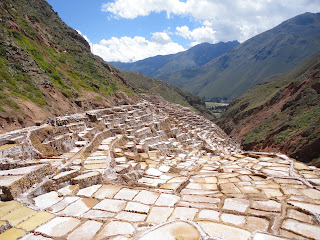On the two hour journey from the Lake to La Paz, it quickly became apparent how much poorer is Bolivia compared to Peru. Their red, yellow and green flag looks African and their are lots of similarities with the "dark continent". We passed indigenous people working in the fields with their animals (the various native groups make up 75% of the population) before we reached the outskirts of El Alto, the suburb above La Paz.
 |
| A view of La Paz |
Morales is allied to Venezuela president Hugo Chavez and his anti-western stance has led to the drying up of foreign investment. His threats to seize foreign owned assets have therefore back-fired and an already poor country is struggling. History has not been kind to Bolivia, which through a combination of wars and treaties has lost around half of its original territory, including a vital 200km of coast to Chile. These reverses, and the instability of a country that lurches between socialist governments and right-wing dicatators who take power via military coups, have taken their toll. The native groups remain poor and industry is underdeveloped despite lots of natural resources. We saw rich parts of the city however and the stats say that Bolivia is one of the most unequal countries in the world in terms of wealth distribution. In many ways its poverty and volatility give it an African feel and, like Africa, the natives are now in charge. They may not be doing a brilliant job but it is better than being ruled by someone else.
We had a fascinating city tour with a guide who is from New York but went to live with her Bolivian mother five years ago. She told us a lot about the current political and economic turmoil to add to the history lesson we had the day before on the bus on the way here. From a vantage point above the old town we saw how the main city sits in a bowl surrounded by poor areas, or Villas (shanty towns) stretching up to El Alto on the top. The poor people really do have the rich surrounded as there are only a couple of ways out of La Paz. As well as seeing the stunning views of the city, we also visited the Witches Market, where all sorts of charms are on sale. Much of it is harmless stuff such as sweets and herbs which are burned in offerings to Pachamama - Mother Earth. However, there is a more sinister side with dried llama foetuses at various stages of development being on sale to make the offering more powerful. Our guide said that these are required as offerings to keep Pachamama happy when a house is erected (on her land). She also said that for bigger buildings, human sacrifices are needed and that for a small fee, local homeless alcoholics can be rounded up and buried alive under the new building, having been induced by the prospect of free booze. All pretty unpleasant if true - who knows if it really is. But being familiar with the magic of Cameroon, I wouldn`t entirely rule it out. When they christened the city "La Paz" (peace) it wasn`t the best choice of name.

















